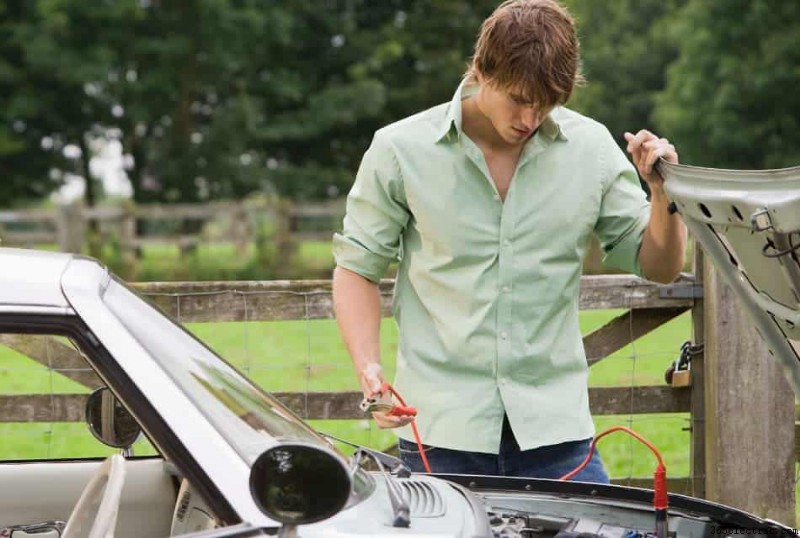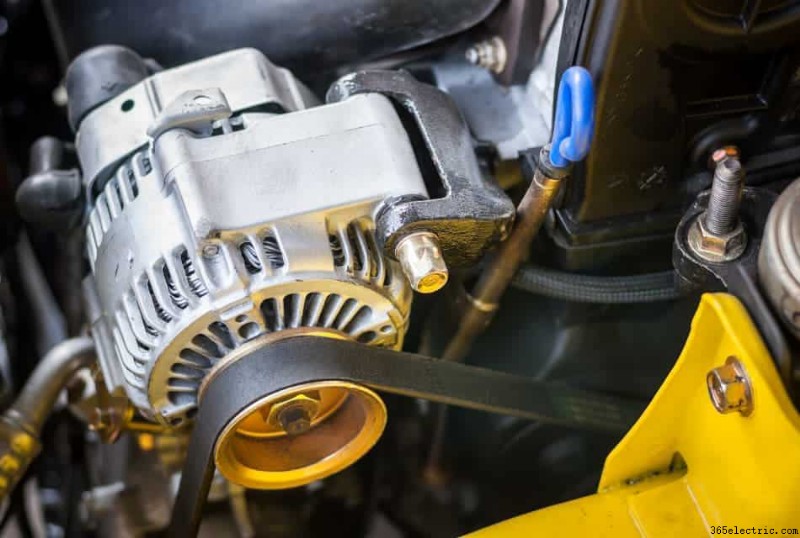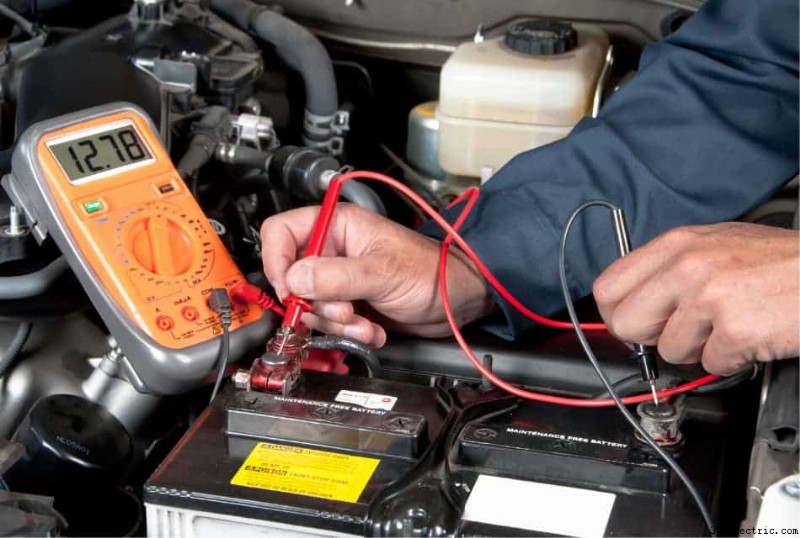Perché l'amplificatore per auto scarica la batteria e come risolverlo?
Molte persone si lamentano del fatto che dopo aver installato l'audio dell'auto il loro subwoofer ha scaricato la batteria dell'auto, ma questo problema è davvero causato da un subwoofer?
Ho fatto delle ricerche per scoprire se un amplificatore per auto può scaricare la batteria e i risultati sono piuttosto interessanti.
Quindi, un amplificatore può scaricare la batteria? La semplice risposta è sì, ma la batteria di un'auto può essere scaricata solo quando invia più energia di quella ricevuta da un alternatore. In altre parole, la batteria di un'auto si scarica quando non è sufficientemente carica, il che è un problema comune quando si utilizzano amplificatori potenti. Inoltre, l'amplificatore scaricherà la batteria quando è collegato direttamente alla batteria, senza che un cavo remoto vada allo stereo. In questo caso, l'amplificatore scaricherà la batteria dell'auto, anche a motore spento.
Scopriamo cosa significa e come risolvere questo problema comune.
Perché un'auto ha bisogno di una batteria?
Il ruolo della batteria in un'auto è avviare un motore e, quando il motore non funziona, la batteria fornisce elettricità a AC, luci, radio e altre apparecchiature dell'auto.
A differenza di molti pensano, una batteria per auto non produce energia, ma immagazzina e fornisce l'equipaggiamento elettrico dell'auto con l'energia prodotta da un alternatore. L'alternatore quando il motore è in funzione fornisce all'auto l'elettricità necessaria e allo stesso tempo carica la batteria.

Non puoi avviare il motore senza batteria. Puoi, tuttavia, provare a spingere un'auto per farla partire dalla collina, ma per farlo devi avere un cambio manuale. Imposta una seconda marcia e, dopo pochi metri, la tua auto funzionerà correttamente.
Ma torniamo all'argomento principale di questo articolo, e parliamo di batterie.
Cosa significa quando la batteria di un'auto è scarica?
Quando si tenta di avviare un motore e dopo aver girato una chiave, non si sente nulla o solo un debole suono di un motorino di avviamento per un secondo o meno, molto probabilmente la batteria è scarica. Potrebbe anche essere un motorino di avviamento rotto, ma nel 99% dei casi, quando non è possibile avviare un motore, il motivo è una batteria scarica.
Mi è successo molte volte, soprattutto negli anni '90, quando guidavo le mie prime auto con batterie usate, cinghie dell'alternatore allentate, ecc.
Il motore non può avviarsi, perché la batteria non ha energia sufficiente per avviare un motorino di avviamento e ci sono diversi motivi per cui la batteria si sta scaricando:
- Hai un potente sistema audio con un alternatore standard o l'alternatore stesso è danneggiato
- L'attrezzatura dell'auto consuma troppa energia quando il motore non funziona. Ad esempio, quando hai lasciato le luci durante la notte o hai ascoltato la musica per molto tempo
- Il livello dell'acqua nella batteria è troppo basso o i terminali della batteria sono ossidati
Il mio sistema audio per auto è troppo potente per la mia batteria?
È una domanda comune quando, dopo aver installato un potente amplificatore, iniziano a comparire problemi con le batterie. Le capacità delle batterie montate in fabbrica sono progettate per adattarsi a un'auto particolare con equipaggiamento standard. Aggiungendo amplificatori aggiuntivi, aumenti i requisiti dell'impianto elettrico, a seconda della potenza dell'amplificatore.
Per calcolare l'esatto amperaggio del tuo amplificatore, devi dividere l'RMS totale del tuo amplificatore (non per canale), per 13,8V. La tabella seguente mostra l'amperaggio per gli amplificatori dell'auto. Ho usato per questo esempio un'efficienza del 70%:
| Amplificatore RMS (Watt) | Amperaggio necessario se l'amplificatore era efficiente al 100% | Amperaggio reale necessario (al 70% di efficienza) |
|---|---|---|
| 100 | 7 | 10 |
| 200 | 14 | 21 |
| 400 | 29 | 41 |
| 600 | 43 | 62 |
| 800 | 58 | 83 |
| 1200 | 87 | 124 |
| 1600 | 116 | 166 |
| 2000 | 145 | 207 |
| 2400 | 174 | 248 |
| 2800 | 203 | 290 |
| 3200 | 232 | 331 |
| 3600 | 261 | 373 |
| 4000 | 290 | 414 |
The table shows how high amperage has to be supported by car alternators, in addition to the standard car equipment.
If your total amperage demand in a car exceeds what your alternator is capable of producing, even the most durable battery will be dead because it always has to support an alternator. In effect, it will never be charged unless you will turn a radio on, and power demand will drop.
When looking at the battery label, you will see two important symbols with numbers behind them. It is worth remembering what they mean.
- Ah – Ampere Hours , that means for how many hours, your battery can supply your car with 12V power. For example, battery Ah65 can continuously provide 1amp for 65 hours or 10amps for 6.5 hours until is fully discharged.
- CCA – Cold Cranking Amps mean how many amps your battery can deliver consistently for 30 seconds in temperature 0°F until voltage will drop below 7.2V.
The table below shows popular conversions between CCA and Ah and how powerful amplifiers you can connect to your battery without further modifications. Assuming that 40% of the battery amperage powers car equipment, and the remaining 60% you can use for car audio amplifier.
| Battery CCA | Battery Ah | Max amplifier RMS |
|---|---|---|
| 410 | 45 | 246 |
| 550 | 100 | 546 |
| 650 | 100 | 546 |
| 680 | 100 | 645 |
| 710 | 120 | 655 |
| 730 | 115 | 628 |
| 740 | 115 | 628 |
| 750 | 120 | 655 |
| 760 | 120 | 655 |
| 850 | 140 | 764 |
| 900 | 160 | 874 |
| 950 | 190 | 1037 |
From the above, you see how powerful amplifier you can install in your car, without facing any later issues with the battery being drained.
For example, when you have a car battery CCA710, you will be OK with a 650W amp, but for a 900W amplifier, this battery is a no-go.
If you listen to the music nonstop while driving, the battery will never be charged by the serial alternator, and it is a matter of time before it will eventually die.
Strong amplifiers do not only cause drained batteries but also you may notice dimming headlights or flickering dash lights. Also, it can happen that the amp will not receive full power, so your bass will be weak.
How to Keep an Amplifier from Draining Battery?

When you have a powerful amplifier, or more than one, and to make sure that your battery will never drain because of the car audio, you have to consider replacing an alternator with the powerful one. This way, you will be able to supply enough energy for your car’s audio system, and at the same time, your battery will always be charged.
A few months ago, I replaced in my wife’s car standard amplifier with Mechman 370A, and it works great. I have had no problem with batteries since then, and she is using a quite powerful Rockville RXH-F5 with 1600W RMS. (link to Amazon opens in the new window)
The new alternator cost me over $500, and yes, it is expensive but when I put this price against risking often battery replacement, and time for a regular charging battery at home, it balances out.
Typical alternators mounted in an average passenger car can produce between 80 – 120A depending on the model. This 80A will support around 660W RMS from the amplifier, and if you do not have more power, you do not need a stronger alternator.
But what will happen when you add a 2000W amplifier to your car for a subwoofer?
This is an additional over 100A, which a standard amplifier simply cannot produce. Many people went through this many times, and the effect was always the same.
A brand new battery was installed, and with a standard alternator after a few weeks or months, the battery was gone, and the process of regular daily recharging at home begins. This is not the way I want to go, I want to have in a car enough power to support my car audio.
When you listen to music mainly when the engine is on, adding a powerful alternator is the only solution to keep your battery in good condition and the whole system without energy shortage.
Before you start making electrical changes in your car, you need to know if this is really necessary, especially when your amplifier is not the most powerful, so its power consumption should be supported by standard car equipment. The best way to find out is to test both a battery and an alternator.
How to Test Battery And Alternator?

Testing the battery voltage and alternator charging quality is the best way to find out how healthy both are.
To perform the test, you need a voltmeter and no more than 5 minutes of your time, you will also need someone to start your engine while you make a test and the whole test can be done at home. I am using Crenova MS8233D digital meter and I am happy with it.
Before the test, make sure both battery terminals are clean and without corrosion. If you notice corrosion on the terminals, you need to clean them.
Take the leads off and clean using sandpaper, then when clean, put them back together. I use it for cleaning sandpaper grids 100 or 120 , and it works well. After that, spray both with a WD40 . This will prevent terminals from getting rusty.
Check alternator wires for any corrosion, if they sit well in the pockets. Also, check if the alternator belt is tight, and if it is not, this will cause a problem while charging a battery.
- Turn headlights on and run it for around 2 minutes
- Do not turn a radio on, or anything else in a car
- Set the voltmeter to value over 12V DC. Depending on the model, it can be 16 or 20V.
- Connect a red voltmeter wire with the positive battery terminal
- Connect a black voltmeter wire with the negative battery terminal (ground)
- Read the value on the voltmeter, for the good battery, you should see over 12.4V, in most cases closer to 13V.
- Do not unplug the voltmeter and start the engine, during start value on the voltmeter should drop to around 10V, and then jump right back to over 13V.
Test Results
When you start an engine and voltage drops below 10V, that means your battery is weak. And if drops below 6V, your battery is dead and needs to be replaced.
If your engine works and you see voltage always between 13.2V and 14.7V, that means the alternator is in good condition and is charging the battery. In this case, you have nothing to worry about, both parts are working great.
- The next step is to turn your electrical equipment on, lights, AC, fan, radio, The value on the voltmeter should drop to over 13V. If you see over 13V with your car audio on, your alternator and battery are in excellent condition.
But, if you see a voltage below 12.7V, that means an alternator does not produce enough power for the demanding equipment in your car and does not charge a battery at the same time. In this case, an alternator should be replaced.
Related Questions
Do I Need a Capacitor For My Car Audio?
Adding a capacitor helps to stabilize voltage in a car. This is especially important for powerful car audio systems, where together with loud bass , you notice dimming headlights. An amplifier and battery cannot handle such a spike in energy demand, so an external capacitor is needed.
In this article , you will find more information about car audio capacitors, which ones to use, and how to connect them.
Do I Need an Extra Battery For Car Audio?
Adding a second car battery works only when you listen to the music with the engine turned off. Extra battery , depending on the amplifier’s power consumption, can extend the listening time from a few minutes to another hour.
When the additional battery is connected in parallel between an original one and amplifier, the whole system works exactly like a standard battery but with extra capacity. To know more about additional batteries for car audio read this article .
